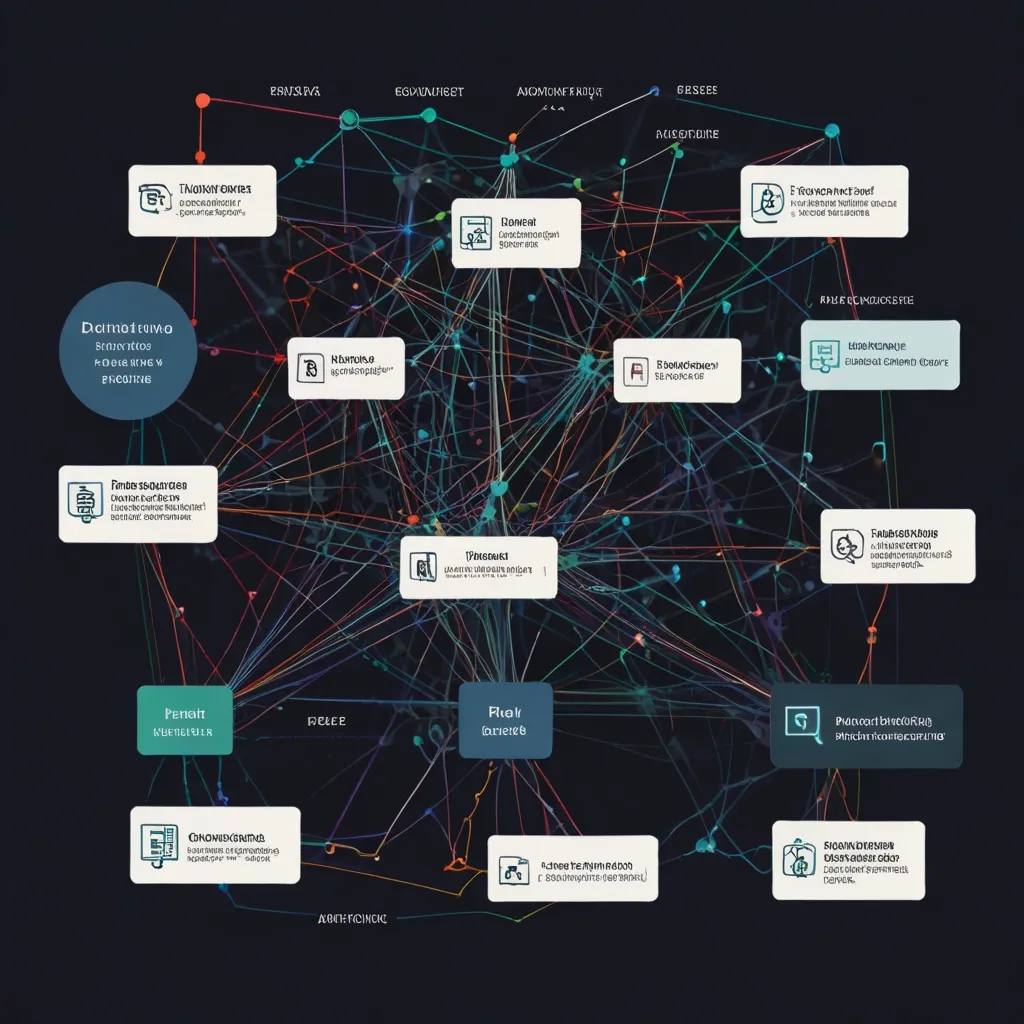Data visualization has come a long way, and with the power of Angular and D3.js, we can create stunning interactive charts that bring our data to life. Let’s dive into the world of dynamic data visualization and explore how we can make our data pop!
Angular, the popular web application framework, provides a robust foundation for building scalable and maintainable applications. When combined with D3.js, a powerful JavaScript library for manipulating documents based on data, we can create jaw-dropping visualizations that not only look great but also provide valuable insights.
To get started, we’ll need to set up our Angular project and install D3.js. If you haven’t already, create a new Angular project using the Angular CLI:
ng new data-viz-project
cd data-viz-project
Next, install D3.js:
npm install d3
Now that we have our project set up, let’s create a simple bar chart to visualize some data. First, we’ll create a new component called ‘bar-chart’:
ng generate component bar-chart
In our bar-chart.component.ts file, we’ll import D3 and set up our component:
import { Component, OnInit, ElementRef } from '@angular/core';
import * as d3 from 'd3';
@Component({
selector: 'app-bar-chart',
template: '<div #chart></div>',
styleUrls: ['./bar-chart.component.css']
})
export class BarChartComponent implements OnInit {
private data = [
{ name: 'A', value: 10 },
{ name: 'B', value: 20 },
{ name: 'C', value: 30 },
{ name: 'D', value: 40 },
{ name: 'E', value: 50 }
];
constructor(private el: ElementRef) {}
ngOnInit() {
this.createChart();
}
private createChart() {
const element = this.el.nativeElement.querySelector('#chart');
const svg = d3.select(element).append('svg')
.attr('width', 400)
.attr('height', 200);
const x = d3.scaleBand()
.range([0, 400])
.domain(this.data.map(d => d.name))
.padding(0.2);
const y = d3.scaleLinear()
.domain([0, d3.max(this.data, d => d.value)])
.range([200, 0]);
svg.selectAll('rect')
.data(this.data)
.enter()
.append('rect')
.attr('x', d => x(d.name))
.attr('y', d => y(d.value))
.attr('width', x.bandwidth())
.attr('height', d => 200 - y(d.value))
.attr('fill', 'steelblue');
}
}
This code creates a simple bar chart using our data. But let’s make it interactive! We can add hover effects and tooltips to make our chart more engaging.
To add hover effects, we can modify our createChart method:
private createChart() {
// ... previous code ...
svg.selectAll('rect')
.data(this.data)
.enter()
.append('rect')
.attr('x', d => x(d.name))
.attr('y', d => y(d.value))
.attr('width', x.bandwidth())
.attr('height', d => 200 - y(d.value))
.attr('fill', 'steelblue')
.on('mouseover', function() {
d3.select(this).attr('fill', 'orange');
})
.on('mouseout', function() {
d3.select(this).attr('fill', 'steelblue');
});
}
Now, when we hover over a bar, it’ll change color to orange, making it stand out.
But why stop there? Let’s add a tooltip to show the exact value when we hover over a bar. First, we’ll create a div to hold our tooltip:
private createChart() {
const tooltip = d3.select('body').append('div')
.attr('class', 'tooltip')
.style('opacity', 0);
// ... rest of the code ...
svg.selectAll('rect')
.data(this.data)
.enter()
.append('rect')
.attr('x', d => x(d.name))
.attr('y', d => y(d.value))
.attr('width', x.bandwidth())
.attr('height', d => 200 - y(d.value))
.attr('fill', 'steelblue')
.on('mouseover', function(event, d) {
d3.select(this).attr('fill', 'orange');
tooltip.transition()
.duration(200)
.style('opacity', .9);
tooltip.html(`Value: ${d.value}`)
.style('left', (event.pageX) + 'px')
.style('top', (event.pageY - 28) + 'px');
})
.on('mouseout', function() {
d3.select(this).attr('fill', 'steelblue');
tooltip.transition()
.duration(500)
.style('opacity', 0);
});
}
Don’t forget to add some CSS for the tooltip in your component’s CSS file:
.tooltip {
position: absolute;
text-align: center;
padding: 8px;
font: 12px sans-serif;
background: lightsteelblue;
border: 0px;
border-radius: 8px;
pointer-events: none;
}
Now we have a interactive bar chart with hover effects and tooltips! But the fun doesn’t stop here. D3.js offers a wide range of chart types and customization options. Let’s explore a few more examples to get your creative juices flowing.
How about a pie chart? Here’s a quick example:
private createPieChart() {
const width = 450;
const height = 450;
const radius = Math.min(width, height) / 2;
const color = d3.scaleOrdinal(d3.schemeCategory10);
const svg = d3.select(this.el.nativeElement).append('svg')
.attr('width', width)
.attr('height', height)
.append('g')
.attr('transform', `translate(${width / 2},${height / 2})`);
const pie = d3.pie()
.value(d => d.value);
const path = d3.arc()
.outerRadius(radius - 10)
.innerRadius(0);
const arc = svg.selectAll('.arc')
.data(pie(this.data))
.enter().append('g')
.attr('class', 'arc');
arc.append('path')
.attr('d', path)
.attr('fill', d => color(d.data.name));
arc.append('text')
.attr('transform', d => `translate(${path.centroid(d)})`)
.attr('dy', '.35em')
.text(d => d.data.name);
}
This code creates a colorful pie chart with labels. You can easily customize the colors, add hover effects, or include tooltips similar to our bar chart example.
What if we want to visualize data that changes over time? A line chart would be perfect for that. Here’s how we can create one:
private createLineChart() {
const margin = {top: 20, right: 20, bottom: 30, left: 50};
const width = 960 - margin.left - margin.right;
const height = 500 - margin.top - margin.bottom;
const parseTime = d3.timeParse('%d-%b-%y');
const x = d3.scaleTime().range([0, width]);
const y = d3.scaleLinear().range([height, 0]);
const line = d3.line()
.x(d => x(d.date))
.y(d => y(d.value));
const svg = d3.select(this.el.nativeElement).append('svg')
.attr('width', width + margin.left + margin.right)
.attr('height', height + margin.top + margin.bottom)
.append('g')
.attr('transform', `translate(${margin.left},${margin.top})`);
// Assume we have data in this format
const data = [
{date: '1-May-12', value: 58.13},
{date: '30-Apr-12', value: 53.98},
{date: '27-Apr-12', value: 67.00},
{date: '26-Apr-12', value: 89.70},
{date: '25-Apr-12', value: 99.00}
];
data.forEach(d => {
d.date = parseTime(d.date);
d.value = +d.value;
});
x.domain(d3.extent(data, d => d.date));
y.domain([0, d3.max(data, d => d.value)]);
svg.append('path')
.data([data])
.attr('class', 'line')
.attr('d', line);
svg.append('g')
.attr('transform', `translate(0,${height})`)
.call(d3.axisBottom(x));
svg.append('g')
.call(d3.axisLeft(y));
}
This code creates a basic line chart. You can enhance it by adding points at each data point, implementing zoom functionality, or adding an area fill below the line.
The possibilities with D3.js and Angular are endless. You can create complex, interactive dashboards that update in real-time, or design custom visualizations tailored to your specific data needs.
Remember, the key to great data visualization is not just making it look pretty, but making it meaningful. Always consider your audience and what insights you want them to gain from your visualization. Don’t be afraid to experiment with different chart types, color schemes, and interactions to find what works best for your data.
As you continue to explore the world of data visualization with Angular and D3.js, you’ll discover new techniques and tricks to make your data truly pop. Keep pushing the boundaries, and soon you’ll be creating visualizations that not only inform but also captivate your audience.
So, what are you waiting for? Dive in, start coding, and let your data tell its story in the most engaging way possible. Happy visualizing!






